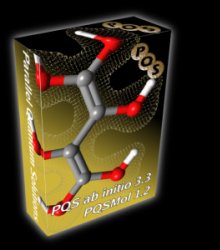PQS ab initio PROGRAM / PQSMol 量子化學計算軟體
 PQS ab initio PROGRAM is the quantum chemistry calculation software which completes the function where Hartree-Fock method and density functional method etc are well used. Good quality of parallel conversion efficiency and structural optimization routine with merit, can realize especially the high-speed characteristic in the calculation which it does as routine work such as property calculation and molecular structural search.
PQS ab initio PROGRAM is the quantum chemistry calculation software which completes the function where Hartree-Fock method and density functional method etc are well used. Good quality of parallel conversion efficiency and structural optimization routine with merit, can realize especially the high-speed characteristic in the calculation which it does as routine work such as property calculation and molecular structural search.
PQSMol is prepared as a graphical user interface. Besides the fact that it can do structural construction and the analysis of the calculation result easily, it is possible also for setting the parallel calculation and throwing to the cuing/queuing system to do on GUI. It is the software which it is easier to use even in the one which is inexperienced to calculation.
PQS ab initio 4.0 quantum chemical calculation software
• An efficient vectorized Gaussian integral package allowing
high angular momentum basis functions and general
contractions.
• Abelian point group symmetry throughout; utilizes full point
group symmetry (up to Ih) for geometry optimization step
and Hessian (2nd derivative) CPHF.
• Closed-shell (RHF) and open-shell (UHF) SCF energies and
gradients, including several initial wavefunction guess options.
Improved SCF convergence for open-shell systems.
• Closed-shell (RHF) and open-shell (UHF) density functional
energies and gradients including all popular exchange-correlati
on functionals: VWN, B88, OPTX, LYP, P86, PW91, PBE, B97,
HCTH, B3LYP, make up your own functional etc.
• Fast and accurate pure DFT energies and gradients for large
basis sets using the Fourier Transform Coulomb (FTC) method.
• Efficient, flexible geometry optimization for all these methods
including Baker's Eigenvector Following (EF) algorithm for mini
for minimization, use of Cartesian, Z-matrix and delocalized int
zation of molecular clusters and adsorption/reaction on model
• Full range of geometrical constraints including fixed distances,
atoms in the molecule and frozen (fixed) atoms. Atoms involve
unlike with a Z matrix - desired constraints do not need to be
satisfied in the starting geometry.
• Analytical (and numerical) second derivatives for all these
methods, including the calculation of vibrational frequencies,
IR intensities, VCD rotational strengths and thermodynamic
analysis.
• Efficient NMR Chemical Shifts for closed-shell HF and DFT
wavefunctions.
• A full range of effective core potentials (ECPs), both
relativistic and non-relativistic, with energies, gradients,
analytical second derivatives and NMR.
• Closed-shell MP2 energies and analytical gradients and dual-
basis MP2 energies; numerical MP2 second derivatives.
• Potential scan, including scan + optimization of all other
degrees of freedom.
• Reaction Path (IRC) following using either Z-matrix, Cartesian
or mass-weighted Cartesian coordinates.
• Conductor-like screening solvation model (COSMO) including
energies, analytical gradients, numerical second derivatives
and NMR.
• Population analysis, including bond orders and atomic valencie
s (with free valencies for open-shell systems); CHELP and Cioslo
wski charges.
• Weinhold's Natural Bond Order (NBO) analysis, including
natural population and steric analysis.
• Properties module with charge, spin-density and electric field
gradient at the nucleus.
• Polarizabilities and dipole and polarizability derivatives;
Raman intensities.
• Full Semiempirical package, both open (unrestricted) and
closed-shell energies and gradients, including MINDO/3,
MNDO, AM1 and PM3. For the latter, all main group elements
through the fourth row (except the noble gases) as • well as
Zinc and Cadmium, have been parametrized.
• Molecular Mechanics using the Sybyl 5.2 and UFF Force Fields.
• QM/MM using the ONIOM method.
• Molecular dynamics using the simple Verlet algorithm.
• Pople-style input for quick input generation and compatibility
• Graphical input generation and display
• All major ab initio functionality is fully parallel (except MP2
grad ients which is serial only - parallel version under
development).


